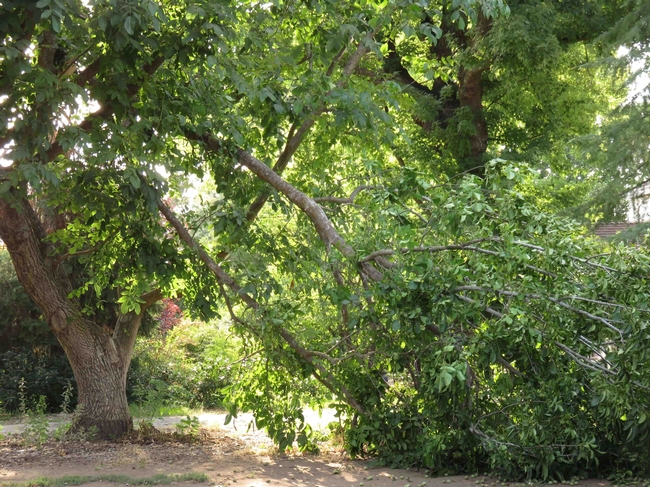By Brent McGhie, Butte County Master Gardener, August 14, 2015

Summer branch drop is not related to wind and often occurs in the afternoon on hot, calm days. Unlike most breaks due to wind, which occur where a branch attaches to the trunk, a break due to summer branch drop usually occurs 3 to 12 feet away from the trunk, along the length of the branch. The branches that break are usually long and horizontal, as opposed to upright, frequently extending to or beyond the average tree canopy. While some limbs that drop show evidence of wounds or decay, many of these failed limbs appear to be quite sound. Older, less vigorous trees seem to be more prone to this problem. Once a tree has lost a limb due to summer branch drop, it is more likely to lose another.
Drought stress may somehow contribute to summer branch drop, but at this time, there is no generally accepted hypothesis that explains this occurrence. In California this type of limb failure occurs on both native and planted trees as well as in irrigated and un-irrigated landscapes. One possibility is that drought stress during a hot calm afternoon reduces the flow of water in the branch, causing the branch temperature and the concentration of ethylene to increase. Ethylene, a gaseous hormone found in all plants, is known to promote the process of cell aging. Elevated levels of ethylene may weaken the cell wall cementation which when coupled with reduced transpiration and increased root pressure, increases internal sap pressure, moisture content of branches, and limb weight, resulting in branch failure. Old wounds and decay hidden inside a limb (possibly resulting from improper pruning) occasionally contribute to branch drop, but this does not account for the majority of summer branch drop failures. Pruning that encourages uneven growth at the end of a limb can put tremendous stress on the limb due to the added weight of the new growth.
Although there is no guaranteed way to prevent summer branch drop, several things can be done to mitigate this hazard in oaks and other commonly affected tree species such as eucalyptus, elm, and ash. On mature trees, shorten and lighten long horizontal branches and open up the tree by thinning to healthy lateral branches to reduce branch weight. Inspect the tree for externally visible defects and prune out damaged or sickly low-vigor limbs that have decay or cavities. Although watering is required to keep most ornamental trees healthy in our hot summer climate, don't forget that summer moisture can encourage oak root fungus and other oak pathogens that can kill oaks when the summer-watered area is within 10 feet of the trunk. Finally, do not park cars or place play structures, benches, or picnic tables beneath older, susceptible trees. Falling limbs can't harm people (or property) if they aren't under the tree.


